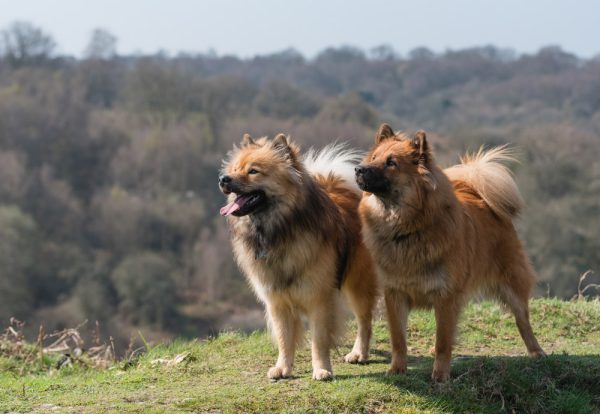In this article
View 8 More +The Silkyhuahua, also called the Silky Chi, is a cross between a Silky Terrier and a Chihuahua. It’s what’s known as a designer mixed breed dog, created to combine the desired characteristics of two separate breeds.
So, what do you get when you cross a Silky Terrier with a Chihuahua? The Silkyhuahua is a toy-sized companion dog known for its perky and lively personality and soft coat.
Breed Overview
Height
7 – 10 inches
Weight
4 – 10 pounds
Lifespan
15- 20 years
Colors
White, black, grey, brown and cream
Suitable for
Attentive owners, homeowners, families with older children, homes without other dogs
Temperament
Loyal, Alert, Funny, Territorial, and Emotionally needy
Like the Silky Terrier and the Chihuahua, it is a small dog with a big personality.
Is the Silkyhuahua the perfect mixed-breed dog for you? We’ll look at all you need to know about this popular mix.
Silkyhuahua Characteristics
 Silkyhuahua Puppies
Silkyhuahua Puppies
The most important thing to keep in mind when searching for any popular mixed breed puppy is to work with a reputable breeder and avoid puppy mill dogs.
Silkyhuahas for sale at retail pet stores and in online ads can come from puppy mills. Be sure to do your research and find a small breeder who welcomes clients into their homes and provides references and health guarantees.

Temperament & Intelligence of the Silkyhuahua
What kind of dog can you expect to have when your Silkyhuahua puppy grows up? Your dog’s personality comes not only from a good upbringing and training but also from the characteristics of the parent breeds.
Both the Silky Terrier and the Chihuahua are known for their lively, alert, and energetic temperaments.
The Silky is a toy dog, but its ancestors were working Terriers, bred to hunt small animals. Terriers are known for their feisty and determined nature.
The Chihuahua is also well known for its big personality. Although the Chihuahua is a true companion animal, dog breed experts say it has a Terrier-like personality.
You can expect your Silkyhuahua to be alert, lively, and a bit assertive. Although small, the Silkyhuahua may be more energetic than a typical lap or purse toy dog.
Are These Dogs Good for Families?
Like other very small dogs, the Silkyhuahua is generally not recommended for families with small children. They can be a little too small and delicate for rough play and handling.
A small dog like the Silkyhuahua can snap or bite when handled roughly, so they are a better fit for adults and families with older children.
Does This Breed Get Along with Other Pets?
Sociability with strangers and other pets can depend on the personality of the individual dog. Generally, Silkyhuahuas are friendly and playful, but your dog may inherit certain traits from the parent breeds.
Some Chihuahuas may not feel comfortable around unfamiliar people and animals. The Silky Terrier can sometimes exhibit protective “watchdog” behavior, and some may have a strong prey drive around other animals like cats.
The best way to ensure that your Silkyhuahua gets along with other pets is to talk to your breeder about your puppy’s early environment and socialization. An in-person visit is a good way to observe how the dog behaves around other animals in the breeder’s home.
Good training and socialization are also important factors in how well your dog gets along with other pets. A group puppy kindergarten class can be a helpful way to start your Silkyhuahua off on the right track.
 Things to Know When Owning a Silkyhuahua:
Things to Know When Owning a Silkyhuahua:
Food & Diet Requirements
Feed your Silkyhuahua a quality diet that is appropriate for its age and size. Choose a dog food that is formulated for your dog’s current life stage (puppy, adult, senior). A food designed for small/toy dogs can also be helpful.
Silkyhuahuas are energetic but making sure they are at a good body weight is still important. Some Chihuahuas can become overweight. To keep your Silkyhuahua at an ideal weight, limit treats and high-fat table scraps.
Exercise
The Silkyhuahua is an energetic and playful dog that appreciates interactive play and exercise with its owners. The amount and type of exercise can vary, depending on the dog.
Chihuahuas often do fine with short walks around the neighborhood. Silky Terriers tend to need more exercise than Chihuahuas. Terriers, in general, enjoy challenging activities like agility training.
Your Silkyhuahua may favor one parent breed over the other when it comes to exercise, but 30 to 60 minutes per day of some form of activity is a good goal for most toy and small dogs.
Training
Training is important for small dogs with big personalities like the Silkyhuahua. Keep in mind that the parent breeds can be feisty and independent-minded.
It’s easy for owners to let cute small dogs get away with naughty behavior, especially when they’re puppies, so a good training plan that starts in puppyhood is essential.
Silkyhuahua puppies can benefit from organized puppy kindergarten classes. At home, be sure to use very small treats for positive reinforcement training. Getting on your dog’s level can also be helpful.
Small dogs have a reputation for being difficult to housebreak. Sometimes this is simply because a tiny dog’s body can’t hold as much as a larger dog’s.
Training experts warn against certain bad habits common to small dog owners, like letting your dog eliminate on paper or in the crate rather than taking it outside.
Take your Silkyhuahua puppy outside for regular and frequent bathroom breaks, even once every hour in the beginning if needed.
Grooming ✂️
The Silky Terrier has a single coat that is long and straight. Chihuahuas can have two types of coats, smooth (short) and long. Your Silkyhuahua can have a short coat, long coat, or something in between.
A long-coated Silkyhuahua should be brushed around twice a week. Some owners also like to use metal combs on longhaired dogs that are prone to mats.
Dogs with that in-between medium coat generally can benefit from a once-a-week brushing. Shorthaired dogs should need just occasional brushing.
Other grooming requirements for the Silkyhuahua include baths, nail trimming, tooth brushing, and ear cleaning.
Health and Conditions
Like most mixed-breed dogs, there is not much specific health information on the Silkyhuahua, so we need to turn to the known health information for the two parent breeds.
The Silky Terrier and the Chihuahua have some inherited health conditions that can be passed on to Silkyhuahua offspring.
Choosing a good breeder is the best way to get a healthy Silkyhuahua puppy and avoid costly health problems down the road.
We’ll look at the most common health problems seen in the Silky Terrier and the Chihuahua, as well as some other health issues seen in many small dog breeds.
- Sometimes a Silkyhuahua’s small size can lead to health problems. Small dogs can be especially prone to dental disease because those little mouths lead to crowded teeth and periodontal disease.
- A dog’s small size can also make it more prone to pancreatitis, and inflammation of the pancreas after eating too much rich and fatty people food. And anyone who’s ever seen a tiny Chihuahua shivering knows that very small dogs can be quite sensitive to extreme cold. Severe hypothermia (low body heat) can be fatal if left untreated.
- Heart disease: The Chihuahua is known to have two heart problems. The first is an inherited heart defect called patent ductus arteriosus (PDA), which can lead to an enlarged heart. The second is mitral valve disease (MVD), a degenerative heart valve condition.
- Joint Problems: Both the Chihuahua and the Silky Terrier can suffer from a couple of joint issues common in many small dog breeds. Both parent breeds can have an inherited condition called patellar luxation, which causes the kneecap to slip out of place. Another small dog joint condition seen in the Silky Terrier and Chihuahua is called Legg-Calve-Perthes Disease (LCP), a painful hip joint disease that can occur before 1 year of age.
- Degenerative eye problems: The Silky Terrier and Chihuahua breeds can have inherited eye disease, primarily progressive retinal atrophy (PRA) and progressive rod-cone degeneration (PRCD). Both cause vision loss in affected dogs.
Male vs Female
What’s the difference between a male and a female Silkyhuahua?
While males tend to be bigger than females in large breed dogs, this is not an issue with small breed dogs.
The biggest sex differences are usually in temperament, but these become much less significant once a dog is spayed or neutered.
Spaying/neutering, combined with good training, are the best ways to solve behavior problems in your dog.
An intact male dog can be territorial, aggressive, and restless. Neutering can solve these unwanted behaviors. Before spaying, females may act restless and irritable as well.
Spaying and neutering your Silkyhuahua will also prevent unexpected litters of puppies and some health problems, like certain cancers and a serious uterine infection in females called pyometra.
3 Little-Known Facts About the Silkyhuahua
1. Unlike some other designer mixes, the origin of the Silkyhuahua is unknown.
There isn’t any documentation that covers the origin of this hybrid. However, the Chihuahua is descended from an ancient dog of Mexico called the Techichi, which was prized by the Aztecs long before Spanish explorers arrived in Mexico.
2. A Silkyhuahua can have a short, long, or medium-length coat.
Slikies generally have a double coat, but the length is determined by the dominant parent genes.
3. The Silkyhuahua has globetrotting parent breeds.
The Silky Terrier was developed in Australia and is itself a mix of several different Terrier breeds (including the Yorkshire and Australian Terriers and possibly the Cairn, Dandie Dinmont, and Skye Terriers).
Final Thoughts
The Silkyhuahua may be small but makes up for it in personality. A combination of the spirited Silky Terrier and the spicy Chihuahua, the Silkyhuahua can be a charming and entertaining companion.
If you’re looking for a smart and lively dog, this cute and perky mixed breed could be a great choice for your next best friend.
Remember to replace this with the relevant info for this dog breed!

 Silkyhuahua Puppies
Silkyhuahua Puppies

















